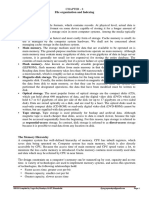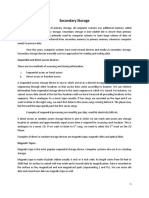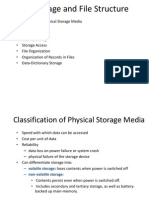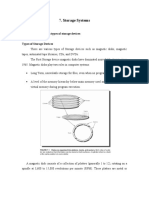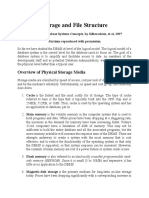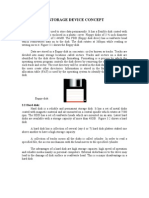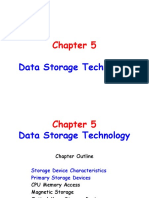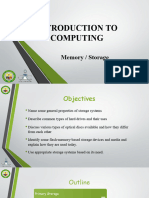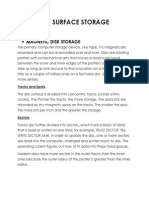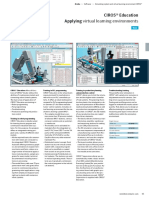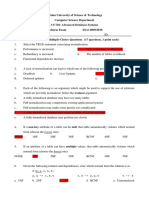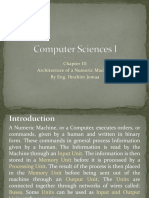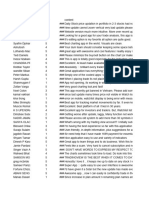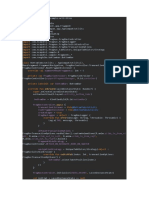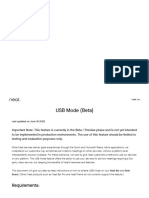Overview of Physical Storage Media
Several types of data storage exist in most computer systems. These storage media are classified by the speed with
which data can be accessed, by the cost per unit of data to buy the medium, and by the medium’s reliability. Among
the media typically available are these:
• Cache. The cache is the fastest and most costly form of storage. Cache memory is small; its use is managed by the
computer system hardware. We shall not be concerned about managing cache storage in the database system.
• Main memory. The storage medium used for data that are available to be operated on is main memory. The general-
purpose machine instructions operate on main memory. Although main memory may contain many megabytes of
data, or even gigabytes of data in large server systems, it is generally too small (or too expensive) for storing the
entire database. The contents of main memory are usually lost if a power failure or system crash occurs.
• Flash memory. Also known as electrically erasable programmable read-only memory (EEPROM), flash memory
differs from main memory in that data survive power failure. Reading data from flash memory takes less than 100
nanoseconds (a nanosecond is 1/1000 of a microsecond), which is roughly as fast as reading data from main memory.
However, writing data to flash memory is more complicated—data can be written once, which takes about 4 to 10
microseconds, but cannot be overwritten directly. To overwrite memory that has been written already, we have to
erase an entire bank of memory at once; it is then ready to be written again. A drawback of flash memory is that it
can support only a limited number of erase cycles, ranging from 10,000 to 1 million.
Flash memory has found popularity as a replacement for magnetic disks for storing small volumes of data (5 to 10
megabytes) in low-cost computer systems, such as computer systems that are embedded in other devices, in hand-
held computers, and in other digital electronic devices such as digital cameras.
• Magnetic-disk storage. The primary medium for the long-term on-line storage of data is the magnetic disk. Usually,
the entire database is stored on magnetic disk. The system must move the data from disk to main memory so that they
can be accessed. After the system has performed the designated operations, the data that have been modified must be
written to disk.
The size of magnetic disks currently ranges from a few gigabytes to 80 gigabytes. Both the lower and upper end of
this range have been growing at about 50 percent per year, and we can expect much larger capacity disks every year.
Disk storage survives power failures and system crashes. Disk-storage devices themselves may sometimes fail and
thus destroy data, but such failures usually occur much less frequently than do system crashes.
• Optical storage. The most popular forms of optical storage are the compact disk (CD), which can hold about 640
megabytes of data, and the digital video disk (DVD) which can hold 4.7 or 8.5 gigabytes of data per side of the disk
(or up to 17 gigabytes on a two-sided disk). Data are stored optically on a disk, and are read by a laser. The optical
disks used in read-only compact disks (CD-ROM) or read-only digital video disk (DVD-ROM) cannot be written,
but are supplied with data prerecorded.
There are “record-once” versions of compact disk (called CD-R) and digital video disk (called DVD-R), which can
be written only once; such disks are also called write-once, read-many (WORM) disks. There are also “multiple-
write” versions of compact disk (called CD-RW) and digital video disk (DVD-RW and DVD-RAM), which can be
written multiple times. Recordable compact disks are magnetic–optical storage devices that use optical means to read
magnetically encoded data. Such disks are useful for archival storage of data as well as distribution of data.
• Tape storage. Tape storage is used primarily for backup and archival data. Although magnetic tape is much cheaper
than disks, access to data is much slower, because the tape must be accessed sequentially from the beginning. For
this reason, tape storage is referred to as sequential-access storage. In contrast, disk storage is referred to as direct-
access storage because it is possible to read data from any location on disk.
Tapes have a high capacity (40 gigabyte to 300 gigabytes tapes are currently available), and can be removed from the
tape drive, so they are well suited to cheap archival storage. Tape jukeboxes are used to hold exceptionally large
collections of data, such as remote-sensing data from satellites, which could include as much as hundreds of terabytes
(1 terabyte = 1012 bytes), or even a petabyte (1 petabyte = 1015 bytes) of data
The various storage media can be organized in a hierarchy (in given Figure) according to their speed and their cost.
The higher levels are expensive, but are fast. As we move down the hierarchy, the cost per bit decreases, whereas the
access time increases.
�This trade-off is reasonable; if a given storage system were both faster and less expensive than another—other
properties being the same—then there would be no reason to use the slower, more expensive memory. In fact, many
early storage devices, including paper tape and core memories, are relegated to museums now that magnetic tape and
semiconductor memory have become faster and cheaper. Magnetic tapes themselves were used to store active data
back when disks were expensive and had low storage capacity. Today, almost all active data are stored on disks,
except in rare cases where they are stored on tape or in optical jukeboxes.
The fastest storage media—for example, cache and main memory—are referred to as primary storage. The media
in the next level in the hierarchy—for example, magnetic disks—are referred to as secondary storage, or online
storage. The media in the lowest level in the hierarchy—for example, magnetic tape and optical-disk jukeboxes—
are referred to as tertiary storage, or offline storage.
In addition to the speed and cost of the various storage systems, there is also the issue of storage volatility. Volatile
storage loses its contents when the power to the device is removed. In the hierarchy shown in Figure, the storage
systems from main memory up are volatile, whereas the storage systems below main memory are nonvolatile. In the
absence of expensive battery and generator backup systems, data must be written to nonvolatile storage for
safekeeping.
�Magnetic Disks
Magnetic disks provide the bulk of secondary storage for modern computer systems. Disk capacities have been
growing at over 50 percent per year, but the storage requirements of large applications have also been growing very
fast, in some cases even faster than the growth rate of disk capacities. A large database may require hundreds of disks.
Physically, disks are relatively simple. Each disk platter has a flat circular shape. Its two surfaces are covered
with a magnetic material, and information is recorded on the surfaces. Platters are made from rigid metal or
glass and are covered (usually on both sides) with magnetic recording material.
When the disk is in use, a drive motor spins it at a constant high speed (usually 60, 90, or 120 revolutions per
second, but disks running at 250 revolutions per second are available). There is a read–write head positioned
just above the surface of the platter.
The disk surface is logically divided into tracks, which are subdivided into sectors. A sector is the smallest
unit of information that can be read from or written to the disk.
The inner tracks (closer to the spindle) are of smaller length, and in current-generation disks, the outer tracks
contain more sectors than the inner tracks.
The read–write head stores information on a sector magnetically as reversals of the direction of magnetization
of the magnetic material. There may be hundreds of concentric tracks on a disk surface, containing thousands
of sectors.
Each side of a platter of a disk has a read–write head, which moves across the platter to access different tracks.
A disk typically contains many platters, and the read –write heads of all the tracks are mounted on a single
assembly called a disk arm, and move together.
The disk platters mounted on a spindle and the heads mounted on a disk arm are together known as head–disk
assemblies. Since the heads on all the platters move together, when the head on one platter is on the ith track,
the heads on all other platters are also on the ith track of their respective platters. Hence, the ith tracks of all
the platters together are called the ith cylinder.
A disk controller interfaces between the computer system and the actual hardware of the disk drive. It accepts
high-level commands to read or write a sector, and initiates actions, such as moving the disk arm to the right
track and actually reading or writing the data.
� Disk controllers also attach checksums to each sector that is written; the checksum is computed from the data
written to the sector. When the sector is read back, the controller computes the checksum again from the
retrieved data and compares it with the stored checksum; if the data are corrupted, with a high probability the
newly computed checksum will not match the stored checksum.
Given Figure shows how disks are connected to a computer system. Like other storage units, disks are connected to
a computer system or to a controller through a high speed interconnection.
The AT attachment (ATA) interface (which is a faster version of the integrated drive electronics (IDE) interface used
earlier in IBM PCs) and a small-computer system interconnect (SCSI; pronounced “scuzzy”) are commonly used to
connect disks to personal computers and workstations.
IMPORTANT:
While disks are usually connected directly by cables to the disk controller, they can be situated remotely and
connected by a high-speed network to the disk controller. In the storage area network (SAN) architecture, large
numbers of disks are connected by a high-speed network to a number of server computers. The disks are usually
organized locally using redundant arrays of independent disks (RAID) storage organizations, but the RAID
organization may be hidden from the server computers: the disk subsystems pretend each RAID system is a very
large and very reliable disk. The controller and the disk continue to use SCSI or Fiber Channel interfaces to talk with
each other, although they may be separated by a network. Remote access to disks across a storage area network means
that disks can be shared by multiple computers, which could run different parts of an application in parallel. Remote
access also means that disks containing important data can be kept in a central server room where they can be
monitored and maintained by system administrators, instead of being scattered in different parts of an organization.
�Disk Scheduling:
One of the responsibilities of the operating system is to use the hardware efficiently. For the disk drives, meeting this
responsibility entails having fast access time and large disk bandwidth. The access time has two major components.
The Seek Time is the time for the disk arm to move the heads to the cylinder containing the desired sector.
The Rotation latency is the additional time for the disk to rotate the desired sector to the disk head.
The disk Bandwidth is the total number of bytes transferred, divided by the total time between the first request for
service and the completion of the last transfer.
We can improve both the access time and the bandwidth by managing the order in which disk I/O requests are
serviced.
FCFS Scheduling
The simplest form of disk scheduling is, of course, the first-come, first-served (FCFS) algorithm. This algorithm is
intrinsically fair, but it generally does not provide the fastest service. Consider, for example, a disk queue with
requests for I/0 to blocks on cylinders in that order. If the disk head is initially at cylinder 53, it will first move from
53 to 98, then to 183, 37, 122, 14, 124, 65, and finally to 67, for a total head movement of 640 cylinders. This
schedule is diagrammed in Figure
98, 183, 37, 122, 14, 124, 65, 67
SSTF Scheduling
It seems reasonable to service all the requests close to the current head position before moving the head far away to
service other request. This assumption is the basis for the Shortest Seek Time First. The SSTF algorithm selects
the request with the least seek time from the current head position.
Since seek time increases with the number of cylinders traversed by the head, SSTF chooses the pending request
closest to the current head position.
�SCAN Scheduling
In this algorithm disk arm starts at one end of the disk and moves toward the other end, servicing requests as it reaches
each cylinder, until it gets to the other end of the disk.
At the other end, the direction of head movement is reversed, and servicing continues. The head continuously scans
back and forth across the disk.
The SCAN algorithm is sometimes called the Elevator Algorithm since the disk arm behaves just like an elevator
in a building, first servicing all the requests going up and then reversing to service requests the other way.
�C-SCAN Scheduling
C-SCAN Scheduling is a variant of SCAN designed to provide a more uniform wait time. Like SCAN, C-SCAN
moves the head from one end of the disk to the other, servicing requests along the way. When the head reaches the
other end, however, it immediately returns to the beginning of the disk without servicing any requests on the return
trip. The C-SCAN scheduling algorithm essentially treats the cylinders as a circular list that wraps around from the
final cylinder to the first one.
LOOK Scheduling
Both SCAN and C-SCAN move the disk arm across the full width of the disk. In practice neither algorithm is often
implemented this way. More commonly the arm goes only as far as the final request in each direction. Then, it reverses
direction immediately without going all the way to the end of the disk Versions of SCAN and C-SCAN that follow
this pattern are called LOOK or C-LOOK and because they look for a request before continuing to move in
a given direction
��File System
The file system is the most visible aspect of an operating system. It provides the mechanism for on-line storage of
and access to both data and programs of the operating system and all the users of the computer system. The file system
consists of two distinct parts: a collection of files, each storing related data, and a directory structure, which organizes
and provides information about all the files in the system.
File:
A file is a named collection of related information that is recorded on secondary storage. From a user's
perspective, a file is the smallest allotment of logical secondary storage; that is, data cannot be written to
secondary storage unless they are within a file.
A common technique for implementing file types is to include the type as part of the file name. The name is
split into two parts-a name and an extension, usually separated by a period character.
File Attributes
A file is named, for the convenience of its human users, and is referred to by its name. A name is usually a string of
characters, such as example.c. Some systems differentiate between uppercase and lowercase characters in names,
whereas other systems do not.
A file's attributes vary from one operating system to another but typically consist of these:
Name. The symbolic file name is the only information kept in human readable form.
Identifier. This unique tag, usually a number, identifies the file within the file system; it is the non-human-
readable name for the file.
� Type. This information is needed for systems that support different types of files.
Location. This information is a pointer to a device and to the location of the file on that device.
Size. The current size of the file (in bytes, words, or blocks) and possibly the maximum allowed size are
included in this attribute.
Protection. Access-control information determines who can do reading, writing, executing, and so on.
Time, date, and user identification. This information may be kept for creation, last modification, and last
use. These data can be useful for protection, security, and usage monitoring.
File Operations
Creating a file. Two steps are necessary to create a file. First, space in the file system must be found for the
file. We discuss how to allocate space for the file in Chapter 11. Second, an entry for the new file must be
made in the directory.
Writing a file. To write a file, we make a system call specifying both the name of the file and the information
to be written to the file. Given the name of the file, the system searches the directory to find the file's location.
The system must keep a write pointer to the location in the file where the next write is to take place. The write
pointer must be updated whenever a write occurs.
Reading a file. To read from a file, we use a system call that specifies the name of the file and where (in
memory) the next block of the file should be put. Again, the directory is searched for the associated entry, and
the system needs to keep a read pointer to the location in the file where the next read is to take place. Once
the read has taken place, the read pointer is updated. Because a process is usually either reading from or
writing to a file, the current operation location can be kept as a per-process. Both the read and write operations
use this same pointer, saving space and reducing system complexity.
Repositioning within a file. The directory is searched for the appropriate entry, and the current-file-position
pointer is repositioned to a given value. Repositioning within a file need not involve any actual I/0. This file
operation is also known as a file seek.
Deleting a file. To delete a file, we search the directory for the named file. Having found the associated
directory entry, we release all file space, so that it can be reused by other files, and erase the directory entry.
Truncating a file. The user may want to erase the contents of a file but keep its attributes. Rather than forcing
the user to delete the file and then recreate it, this function allows all attributes to remain unchanged –except
for file length-but lets the file be reset to length zero and its file space released.
�Access Methods:
1. Sequential Access: The simplest access method is Sequential Access. Information in the file is processed in
order, one record after the other. This mode of access is by far the most common; for example, editors and
compilers usually access files in this fashion.
Reads and writes make up the bulk of the operations on a file. A read operation-read next-reads the next
portion of the file and automatically advances a file pointer, which tracks the I/O location. Similarly, the write
operation-write next-appends to the end of the file and advances to the end of the newly written material (the
new end of file).
Sequential access, which is depicted in Figure, is based on a tape model of a file and works as well on
sequential-access devices.
2. Direct Access: Another method of file access is Direct Access method. A file is made up of fixed length
logical address that allow programs to read and write records rapidly in no particular order. The direct-access
method is based on a disk model of a file, since disks allow random access to any file block. For direct access,
the file is viewed as a numbered sequence of blocks or records. Thus, we may read block 14, then read block
53, and then write block 7. There are no restrictions on the order of reading or writing for a direct-access file.
For the direct-access method, the file operations must be modified to include the block number as a parameter.
Thus, we have read n, where n is the block number, rather than read next, and ·write n rather than write next.
3. Indexed Access: This methods generally involve the construction of an index for the file. The index like an
index in the back of a book contains pointers to the various blocks. To find a record in the file, we first search
the index and then use the pointer to access the file directly and to find the desired record.
�Free Space Management:
Since disk space is limited, we need to reuse the space from deleted files for new files, if possible. To keep track of
free disk space, the system maintains a free space list. The free-space list records all free disk blocks-those not
allocated to some file or directory. To create a file, we search the free-space list for the required amount of space and
allocate that space to the new file. This space is then removed from the free-space list. When a file is deleted, its disk
space is added to the free-space list.
Bit Vector
Frequently, the free-space list is implemented as a bit map or bit vector. Each block is represented by 1 bit. If the
block is free, the bit is 1; if the block is allocated, the bit is 0.
For example, consider a disk where blocks 2, 3, 4, 5, 8, 9, 10, 11, 12, 13, 17,18, 25, 26, and 27 are free and the rest
of the blocks are allocated. The free-space bit map would be
001111001111110001100000011100000 ...
The main advantage of this approach is its relative simplicity and its efficiency in finding the first free block or n
consecutive free blocks on the disk.
Linked List
Another approach to free-space management is to link together all the free disk blocks, keeping a pointer to the first
free block in a special location on the disk and caching it in memory. This first block contains a pointer to the next
free disk block, and so on. Recall our earlier example, in which blocks 2, 3, 4, 5, 8, 9, 10, 11, 12, 13, 17, 18, 25, 26,
and 27 were free and the rest of the blocks were allocated. In this situation, we would keep a pointer to block 2 as the
first free block. Block 2 would contain a pointer to block 3, which would point to block 4, which would point to block
5, which would point to block 8, and so on
�Grouping
A modification of the free-list approach stores the addresses of n free blocks in the first free block. The first n-1 of
these blocks are actually free. The last block contains the addresses of another n free blocks, and so on. The addresses
of a large number of free blocks can now be found quickly, unlike the situation when the standard linked-list approach
is used.
Counting
Another approach takes advantage of the fact that, generally, several contiguous blocks may be allocated or freed
simultaneously, particularly when space is allocated with the contiguous-allocation algorithm or through clustering.
Thus, rather than keeping a list of n free disk addresses, we can keep the address of the first free block and the number
(n) of free contiguous blocks that follow the first block. Each entry in the free-space list then consists of a disk address
and a count.
Allocation Method:
The direct-access nature of disks allows us flexibility in the implementation of files. In almost every case, many files
are stored on the same disk. The main problem is how to allocate space to these files so that disk space is utilized
effectively and files can be accessed quickly. Three major methods of allocating disk space are in wide use:
contiguous, linked, and indexed.
Contiguous Allocation
Contiguous Allocation addresses define a linear ordering on the disk. With this ordering, assuming that only one job
is accessil1.g the disk, accessing block b + 1 after block b normally requires no head movement. When head
movement is needed the head need only move from one track to the next. Thus, the number of disk seeks required
for accessing contiguously allocated files is minimal, as is seek time when a seek is finally needed.
Accessing a file that has been allocated contiguously is easy. For sequential access, the file system remembers the
disk address of the last block referenced and, when necessary, reads the next block. For direct access to block i of a
file that starts at block b, we can immediately access block b + i. Thus, both sequential and direct access can be
supported by contiguous allocation.
�Linked Allocation
Linked Allocation solves all problems of contiguous allocation. With linked allocation, each file is a linked list of
disk blocks; the disk blocks may be scattered anywhere on the disk. The directory contains a pointer to the first and
last blocks of the file. For example, a file of five blocks might start at block 9 and continue at block 16, then block 1,
then block 10, and finally block 25. Each block contains a pointer to the next block. These pointers are not made
available to the user.
�Indexed Allocation
Indexed Allocation bring all the pointers together into one location: the Index block.
Each file has its own index block, which is an array of disk-block addresses. The ith entry in the index block points
to the ith block of the file. The directory contains the address of the index block. To find and read the ith block, we
use the pointer in the ith index-block entry. This scheme is similar to the paging scheme.
